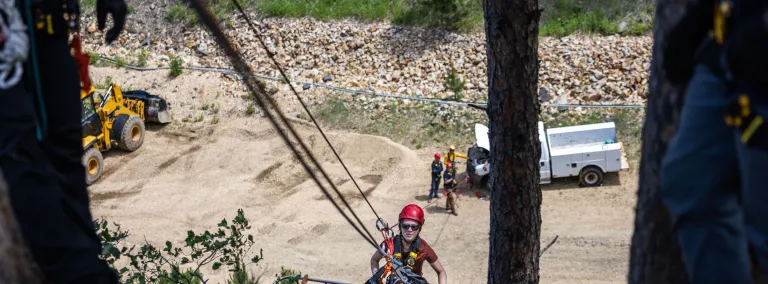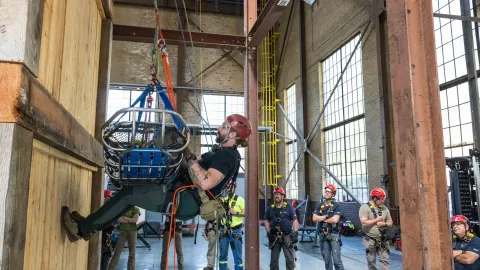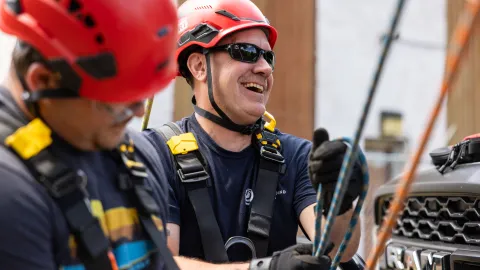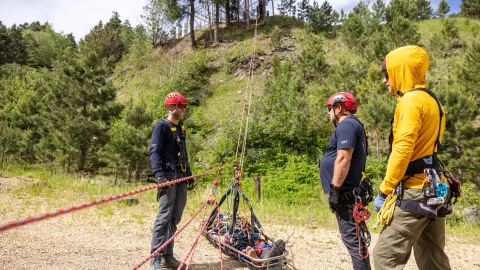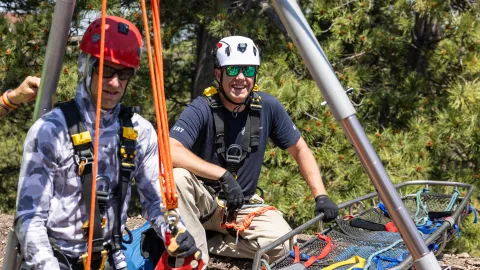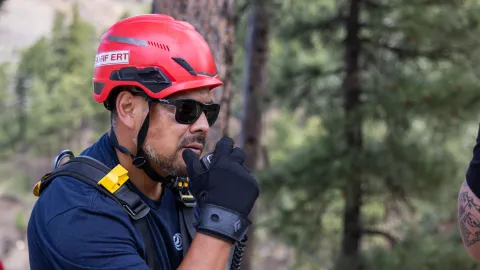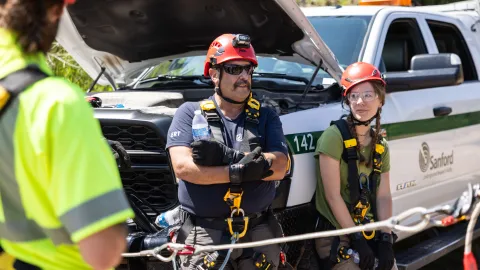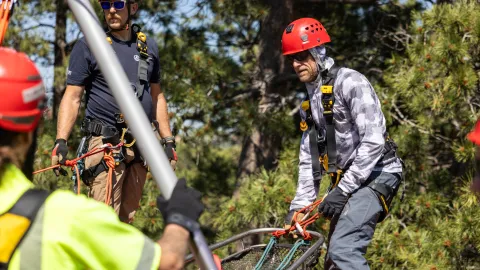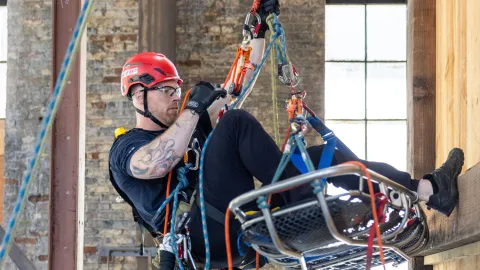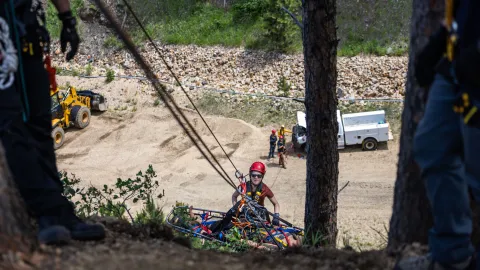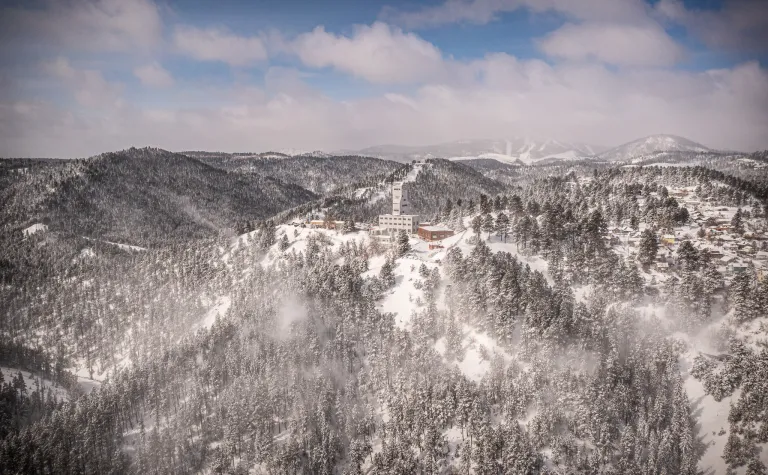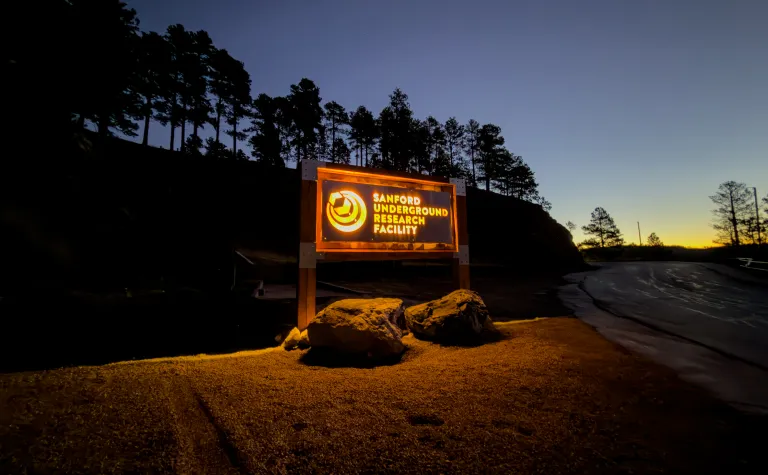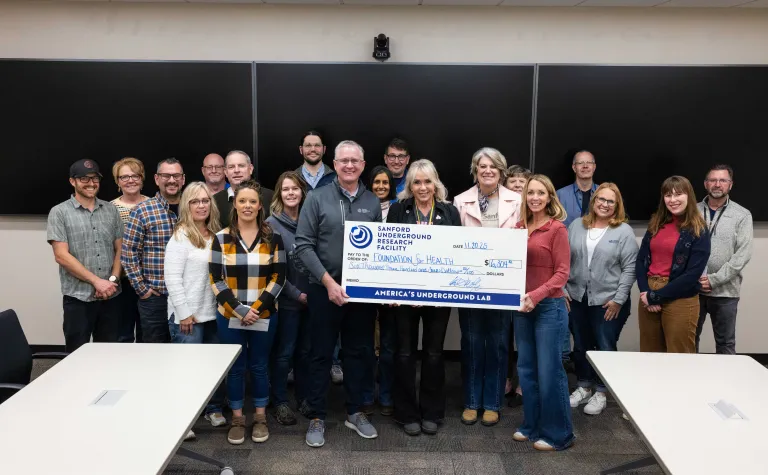SURF Emergency Response Team hones rope rescue skills with local experts
The conveyances at SURF routinely travel a mile below the surface. This means trained rescue professionals are essential, as they can quickly get people to safety in the unlikely event anything goes wrong.
The Sanford Underground Research Facility (SURF) was once the deepest gold mine in North America. SURF includes two former mine shafts, each about 5,000 feet deep, that facilitate daily transports of equipment and personnel who advance world-class research across multiple disciplines.
When conveyances routinely travel a mile below the surface, trained rescue professionals are essential, as they can quickly get people to safety in the unlikely event anything goes wrong. This is where SURF’s Emergency Response Team (ERT) steps in. The team is comprised of 35 people, including full-time and part-time staff. SURF’s ERT is the first responder for all incidents that might happen at the facility. Their emergency calls can range from basic medical responses to rescuing someone off the steep slopes above the town of Lead, or even mine rescue operations in the deep underground.
Barry VanSickle, the supervisor of SURF’s ERT, says that SURF’s unique landscapes, both above and below ground, create an environment that local fire departments and emergency responders generally don’t have the training or equipment to safely complete a rescue mission in these areas. “There's just no one out there that's going to be able to come to our location and effect a rescue without a lot of training, so that's why we're here, and that’s why we train so hard,” VanSickle said.
This summer, SURF took a new step in the effort to improve safety standards and deepen safety culture with an invitation to NIM Medical, a clinical operations and education company based out of Rapid City, SD.
“There's just no one out there that's going to be able to come to our location and effect a rescue without a lot of training, so that's why we're here, and that’s why we train so hard.”
The company specializes in wilderness and wildland fire rescue, training, clinical operations, and austere medicine. VanSickle highlighted NIM Medical’s experience and expertise, saying, “They're really good at what they do. Their main job is to support wildland firefighters, so they're the rescue guys. If a wildland firefighter gets in trouble on a cliff or steep slope, they are the people who go in and get them to safety.”
Over the course of two weeks, NIM Medical and SURF ERT worked closely together in hands-on training sessions designed to improve and strengthen rope rescue operations at the facility. The course included real-world scenarios, practice on cliffsides, and training at SURF’s Ross Hoistroom, which houses a realistic model of the shaft used for rope and rappel practice.
The training course was led by William Buckman, the lead instructor at NIM Medical, and who is a Rescue International rescue technician. He has worked with the National Park Service and National Forest Service in multiple wilderness rescue capacities and graduated from the National Search and Rescue Academy. He also works as a climbing guide at Devil’s Tower National Monument. For Buckman, working with SURF’s ERT was the perfect opportunity to utilize NIM Medical’s expertise.
“Our company being able to teach and train in a variety of environments is a great fit here, because we're used to austere environments and being able to just think on the fly. That's what everybody here has to do. The moment they're going underground, or the moment they're on steep hillsides, they have to be able to adapt whatever techniques they've learned and trained. So being able to see what they're doing and helping them improve has been one of the better classes we've ever had,” Buckman said.
Buckman also emphasized that NIM Medical values hands-on, engaging learning methods over a more traditional safety training course, and they understand SURF’s position as an established, well-trained medical response team. “Our idea of the training aspect isn't to come here and show them what we know and then bounce—it’s to empower them to know what they're doing better, and to have a few techniques that might be different so they have better tools in their toolbox,” he said.
Buckman praised SURF’s ERT for mastery of the multiple skillsets required to operate in the complex surface or mine rescue environment. He says this is thanks to the safety culture at SURF that empowers continuous improvement and training. “When you watch the growth of a team come together, and you see that there is an intention in the teamwork that just speaks well for all the people at SURF,” Buckman said. “We've gone through 20 people in two weeks of this training, and there hasn't been a single attitude that was contrary to what you'd want to see. Everyone has that ‘yes, I'll go do it’ mentality. That's so huge. The culture here at SURF, in the little dynamic that we've seen, has been top-notch.”
While SURF has chosen to do training out-of-state with a different company before, the decision to conduct training in-house has been greatly beneficial. Stephen Kenny, a full-time multimedia designer for SURF’s Communications team and part-time ERT member, noted the importance of hiring a local company. “Not only is it cheaper to train in-house, but it also allows ERT to train on our equipment, which is essential for creating realistic rescue scenarios,” Kenny stated.
The group wrapped up their training with a refreshed understanding of their rescue techniques and a fervor for continuously improving ERT’s capabilities. Training like these are vital to maintaining and furthering SURF’s safety culture and mission. “The SURF safety record speaks for itself,” stated Buckman.
